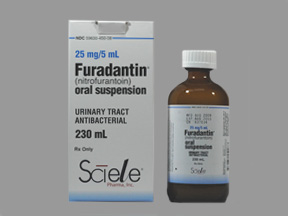Question
Why is nitrofurantoin listed in the Beers List as being inappropriate for use in the elderly?
Response from Darrell Hulisz, PharmD
Associate Professor, Case Western Reserve University School of Medicine; Clinical Specialist in Family Medicine, University Hospitals, Case Medical Center, Cleveland, Ohio
Nitrofurantoin is a broad-spectrum antibiotic with gram-negative and gram-positive activity that is commonly used for lower urinary tract infections (UTIs). Nitrofurantoin is susceptible to enzymatic degradation, so tissue drug concentration is low. The drug is eliminated rapidly by glomerular filtration, and approximately 30% of the active drug is excreted in the urine.[1] In patients with renal impairment, including elderly patients, nitrofurantoin excretion is decreased, and it may not reach adequate urinary minimum inhibitory concentrations.[2] Thus, a primary reason that nitrofurantoin is on the Beers List of medications to avoid in the elderly is inadequate drug concentration in the urine when creatinine clearance falls below 60 mL/min.[3]
Besides the potential subtherapeutic effect of nitrofurantoin in patients with renal impairment, patients may be at increased risk for adverse events secondary to drug accumulation.[3] Case reports of pulmonary toxicity in patients receiving chronic UTI prophylaxis, including pulmonary fibrosis and interstitial pneumonitis, have been reported.[4,5] Peripheral neuropathy, which is mostly seen in elderly women with renal impairment, has also been observed in patients with normal renal function.[6,7]Hepatotoxicity has also been documented in several cases involving women over 50 years old taking nitrofurantoin for acute UTI, recurrent UTI, or prophylaxis.[8] It is unclear whether pulmonary, neuropathic, and hepatic toxicities are directly related to renal impairment or to an accumulation of drug in pulmonary or neurologic tissue due to long-term use or a combination of these 2 processes.
Surprisingly few studies have been published to support the notion of decreased efficacy with nitrofurantoin in the elderly. A retrospective chart review of 356 patients was conducted in 2009 that assessed the efficacy and safety of nitrofurantoin in patients with renal impairment. The study concluded that nitrofurantoin cure rates for UTI and adverse events were similar between those with and those without renal impairment.[1] However, the usual caveats apply when attempting to interpret retrospective data to discern clear answers to clinical questions that are best answered with randomized prospective trials.
It is generally accepted that nitrofurantoin may be ineffective for UTIs in the elderly because age-related declines in renal function result in subtherapeutic concentrations in the urinary tract.[9] However, the recommendation to avoid the drug in the elderly is not because it causes nephrotoxicity. Although not well-documented, it is plausible that the risk for other toxicities from nitrofurantoin, such as pulmonary fibrosis, would increase secondary to drug accumulation.
Acknowledgement: The author wishes to thank and recognize Kady Lynn Lordan for providing technical assistance.
References
-
Bains A, Buna D, Hoag NA. A retrospective review assessing the efficacy and safety of nitrofurantoin in renal impairment. Can Pharm J. 2009;142:248-252.
-
Sachs J, Geer T, Noell P, Kunin CM. Effect of renal function on urinary recovery of orally administered nitrofurantoin. N Engl J Med. 1968;278:1032-1035. Abstract
-
American Geriatrics Society 2012 Beers Criteria Update Expert Panel. American Geriatrics Society updated Beers Criteria for potentially inappropriate medication use in older adults. J Am Geriatr Soc. 2012;60:616-631. Abstract
-
Williams EM, Triller DM. Recurrent acute nitrofurantoin-induced pulmonary toxicity. Pharmacotherapy. 2006;26:713-718. Abstract
-
Mendez JL, Nadrous HF, Hartman TE, Ryu JH. Chronic nitrofurantoin-induced lung disease. Mayo Clin Proc. 2005;80:1298-1302. Abstract
-
Kammire LD, Donofrio PD. Nitrofurantoin neuropathy: a forgotten adverse effect. Obstet Gynecol. 2007;110(2 Pt 2):510-512.
-
Spring PJ, Sharpe DM, Hayes MW. Nitrofurantoin and peripheral neuropathy: a forgotten problem? Med J Aust. 2001;174:153-154.
-
Adverse Drug Reactions Advisory Committee. Hepatic toxicity with nitrofurantoin. Aust Adverse Drug Reac Bull. 2008;27:11.
-
Kunin CM. Inappropriate medication use in older adults: does nitrofurantoin belong on the list for the reasons stated? (letter) Arch Intern Med. 2004;164:1701.






 留言列表
留言列表
 線上藥物查詢
線上藥物查詢 